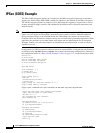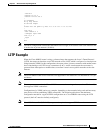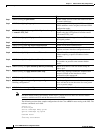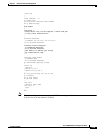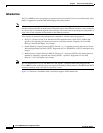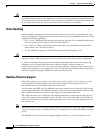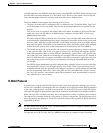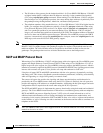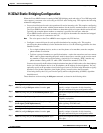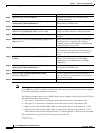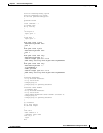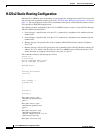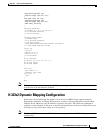
4-4
Cisco uBR924 Software Configuration Guide
OL-0337-05 (8/2002)
Chapter 4 Voice over IP Configurations
Overview
Caution In certain countries, the provisioning of voice telephony over the Internet or use of these products may
be prohibited and/or subject to laws, regulations or licenses, including requirements applicable to the use
of the products under telecommunications and other laws and regulations; customer must comply with
all such applicable laws in the country where the customer intends to use the product.
Voice Handling
With IP telephony, telephone calls can be delivered at rates as low as 8 kbps in a packet format using
compression algorithms. Depending on the software release used, the Cisco uBR924 cable access router
supports the following algorithms:
• G.711 A-Law—64000 bps PCM uncompressed encoding, using the A-Law standard used in most of
the world except for North America and a few other countries.
• G.711 Mu-Law—64000 bps PCM uncompressed encoding, using the Mu-Law standard used in
North America and a few other countries.
• G.729—8000 bps compressed CS-ACELP encoding (default for telephone calls).
Caution Because voice is delay-sensitive, a well-engineered network is critical. Fine-tuning your network to
adequately support VoIP typically involves a series of protocols and features geared to support QoS.
To achieve acceptable voice quality and reduce network bandwidth usage, several voice processing
techniques are used. Digital Signal Processors (DSPs) provide the stream-to-packet and
packet-to-stream conversion, as well as voice processing capabilities. Typical voice processing services
include echo cancellation, voice compression, Voice Activity Detection (VAD) or silence compression,
and Dual Tone Multi-Frequency (DTMF) tone detection and generation.
Quality of Service Support
Data traffic typically is sent only on a “best effort” basis, and if a packet is lost or delayed, it can be
easily retransmitted without significantly affecting the connection. Such delays and losses are
unacceptable, however, for real-time traffic such as voice calls.
For this reason, the CMTS and Cisco uBR924 router assign separate service identifiers (SIDs) for the
voice and data traffic flows. Each SID has a separate class of service (CoS) that determines how its traffic
flow is handled, allowing voice traffic to have a higher priority than the data traffic.
The CMTS and router can use different traffic shaping mechanisms to ensure that the higher priority
voice traffic always has the bandwidth it needs. This allows voice calls (and other real-time traffic) to
share the same channel as data traffic, without the quality of the voice calls being degraded by bursty
data transmissions.
Note Separate CoS flows are available only when the router is connected to a CMTS that supports multiple
classes of service per router. In addition, the router’s configuration file must enable multiple classes of
service.
The DOCSIS 1.0 specification does not support multiple CoS flows, so this flow technique is not



